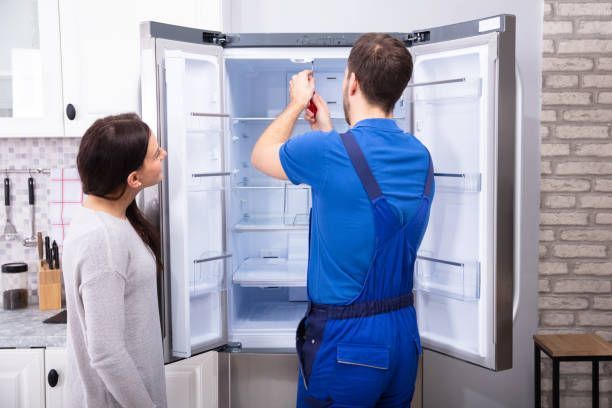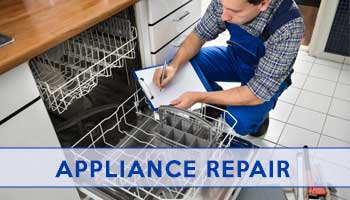Are You Overpaying on Energy Bills? Find Out with a Call to Dependable Refrigeration Appliance SubZero repair near me
Are You Overpaying on Energy Bills? Find Out with a Call to Dependable Refrigeration Appliance SubZero repair near me
Blog Article
The Ultimate Guide to Do It Yourself Device Repair Work Techniques
From refrigerators to dish washers, recognizing how to troubleshoot and repair these devices can conserve you time and cash. Are you all set to find important methods that will encourage you to handle repair work confidently?
Recognizing Typical Home Appliance Issues
When you count on your home devices, it can be discouraging when they instantly stop working or act up. Understanding common device troubles can aid you troubleshoot problems efficiently. If your refrigerator isn't cooling, examine the temperature level settings or check the door seal for spaces. A malfunctioning washing equipment may be because of a clogged up drain filter or a busted belt.
If your oven isn't heating, damaged aspects or thermostat issues might be to blame,. Dish washers commonly experience issues with drainage, so ensure the filter is clean and the drainpipe hose pipe isn't kinked.
Additionally, listen for uncommon noises; they often show mechanical issues. By acknowledging these signs, you can save time and possibly prevent pricey repair services. A little knowledge goes a long means in preserving your devices, so stay informed to maintain every little thing running efficiently.
Vital Tools for Do It Yourself Repair Works
Prior to diving into DIY device repairs, it's crucial to collect the right tools to assure the process goes smoothly. Begin with an excellent set of screwdrivers, including both flathead and Phillips, as they're crucial for opening up most devices. You'll additionally want a pair of pliers for grasping and turning cords or tiny components.
Do not fail to remember a multimeter; it aids you test electric parts and detect problems efficiently. A socket set is convenient for loosening or tightening bolts, while an utility blade can be valuable for opening up or reducing cords packaging.
Finally, consider having a flashlight handy to brighten dark rooms inside your appliances. With these important tools, you'll be well-appointed to tackle different repairs, saving both time and money. Gather your equipment and obtain all set to roll up your sleeves!
Safety And Security First: Precautions to Take
Before you start any appliance repair, it's important to prioritize safety. Make certain you wear individual safety devices, detach the power source, and keep your workspace arranged. These basic safety measures can help protect against accidents and guarantee a smoother repair service process.

Personal Protective Devices
Security gear is a vital part of any kind of DIY appliance fixing job. Steel-toed boots are also a clever choice, particularly when lifting hefty appliances. Bear in mind, being prepared with the ideal gear maintains you safe and focused on finishing your repair efficiently.
Source Of Power Interference
To assure a secure Do it yourself home appliance repair service, separating the power source is vital. This basic action protects against electrical shocks and warranties that you can concentrate on the repair without worrying about unintentional activation. When you're positive that the power is disconnected, you can confidently continue with your repairs, recognizing you have actually taken the required preventative measures to secure yourself.
Workspace Organization
A well-organized job area can make all the distinction in your DIY device repair work task. Start by removing your workspace of mess to avoid crashes and disturbances. A tidy area not just increases effectiveness yet also maintains you secure while you work on your device repair.
Step-by-Step Overview for Fridge Fixes
When your refrigerator starts breaking down, it can be aggravating, yet taking on the problem yourself can save you time and cash. Initially, disconnect the fridge to ensure safety and security. Inspect for usual issues like temperature changes or uncommon sounds. If it's not cooling down, examine the thermostat settings; they may be set expensive. Next off, tidy the condenser coils, which typically accumulate dirt and particles. For a loud refrigerator, inspect the follower and verify it's not obstructed.
If there's water pooling inside, inspect the door seals for damage or dirt, and clean them if required. For ice buildup, clear the defrost drain. Plug the refrigerator back in and check it for a couple of hours once you've dealt with the issue. If the trouble lingers, you might need to change a damaged component, like the compressor or follower motor. Remember, don't wait to seek advice from the handbook or seek specialist aid if required.
Repairing Washing Equipment Problems
Similar to fridges, washing equipments can present their own collection of challenges, however several issues can be fixed with a little bit of troubleshooting. If your equipment won't begin, examine the power cable and validate it's plugged in. Next, examine the door latch; read this a faulty latch can stop the cycle from starting. If you notice unusual noises during operation, it could be as continue reading this a result of international objects stuck in the drum or the drain pump.
Tightening up these can usually address the trouble. Normal upkeep, like cleaning the filter, can prevent several problems from arising.
Repairing Stoves and Stoves
Exactly how can you troubleshoot usual problems with your stove or range? Beginning by inspecting the power supply.
If your oven isn't heating, inspect the temperature settings and validate the door seals securely. If it's harmed., a defective home heating element might likewise be the culprit; you may require to replace it.
For unequal food preparation, turn your pans and take into consideration using a stove thermostat to validate precise temperature levels. Finally, if you hear uncommon noises or smell gas, transform off the device right away and consult an expert. By adhering to these actions, you can recognize and resolve lots of typical stove and cooktop concerns successfully.
Fixing Dishwashers Made Easy
When your dishwasher starts acting up, it can be discouraging, however attending to usual concerns isn't as difficult as it appears. You'll find out detailed troubleshooting techniques that will certainly assist you identify the issue, together with the necessary devices you'll require to tackle repair work yourself. Let's make repairing your dish washer a wind!
Usual Dish Washer Problems
While dish washers are designed to make your life less complicated, they can in some cases run right into common concerns that leave you really feeling annoyed. If your dishwashing machine's door will not lock, it can be a basic problem with the latch system or door seal. Resolving these concerns early can conserve you time and inconvenience down the road.

Detailed Troubleshooting
Prior to diving right into repairs, it's vital to identify the specific concern your dish washer is encountering. If your dishwasher won't start, examine the power supply and door lock. By carefully resolving each possible problem, you can identify see this site the problem and take the required steps to fix it, making your dish washer feature like brand-new once again.
Crucial Repair Devices
Having the right devices at your disposal can make all the distinction when repairing your dish washer. Don't forget a bucket or towels for any kind of water spills throughout repair services.
If you're dealing with obstructions, a drain snake or a wet/dry vacuum will certainly be important. You could likewise desire a level to assure your dishwashing machine's correctly straightened. Security equipment like safety glasses and gloves will certainly protect you while you work. With these important devices, you'll be well-equipped to deal with any kind of dishwasher fixing difficulty that comes your way.
Often Asked Inquiries
Just how Do I Identify if a Device Deserves Fixing?
To establish if a device's worth repairing, consider its age, repair work expenses, and existing worth. If fixings go beyond half the substitute cost, you might want to invest in a brand-new model rather.
Can I Locate Substitute Components Locally for My Appliance?
Yes, you can frequently discover replacement components in your area for your home appliance. Check equipment stores, appliance repair work stores, or neighborhood classifieds. Do not fail to remember to bring the model number to assure you obtain the appropriate component!
What Typical Mistakes Should I Avoid When Fixing Home Appliances?
When fixing appliances, stay clear of rushing via diagnostics, neglecting security preventative measures, or utilizing inaccurate tools. Do not skip reviewing handbooks or seeing tutorials; they supply vital guidance. Be individual and extensive to ensure effective repair work and prevent additional damages.
Exactly how Lengthy Does a Common Do It Yourself Appliance Repair Service Take?
A common do it yourself appliance fixing usually takes one to 3 hours, depending on the complexity. You'll desire to gather your products and tools first, and adhere to instructions very carefully to avoid unnecessary hold-ups.
Exist Any Guarantees for DIY Home Appliance Services?
When you tackle DIY home appliance fixings, warranties normally don't cover your work. Nevertheless, some producers may recognize service warranties for components you replace. Constantly check your appliance's guarantee terms prior to beginning any kind of fixings to avoid issues.
Before diving right into DIY appliance repair work, it's crucial to collect the right devices to ensure the procedure goes efficiently.Prior to you begin any kind of device repair, it's important to prioritize safety.To guarantee a safe DIY appliance repair, detaching the power source is important.An efficient job location can make all the distinction in your DIY appliance repair project. Constantly inspect your device's guarantee terms before starting any kind of fixings to stay clear of problems.
Report this page